Join our Larry McDonald on CNBC’s Trading Nation, Wednesday at 3:05pm ET
Pick up our latest report here:
Don’t miss our next trade idea. Get on the Bear Traps Report Today, click here
In cooperation with ACG Analytics in Washington, we advise institutional investors globally on the GSEs (Government Sponsored Entities) with a focus on Fannie Mae $FNMA.
In recent weeks, the Senate Banking Committee has been working on a regulatory relief bill, while Chairman Mike Crapo is optimistic that a deal on housing finance reform could be next on the agenda (2018). African Americans make up 13% of U.S. Population, but received around 3% of 2014-15 conforming loans (HUD data) – the system is broken and fueling inequality.
Down from the Pre-Financial Crisis Highs
AIG $AIG -96.4%
Fannie $FNMA -96.3%*
Royal Bank Scotland $RBS -95.2%
Citi $C -87.2%
Deutsche Bank $DB -84.6%
Bank of Amer $BAC -51.6%
Morgan Stanley $MS -47.1%
*Over the years we’ve witnessed extreme risk and volatility in these Fannie Mae $FNMA shares – 2017 was no exception. Bloomberg data above.
Below is a recap of Pershing Square’s view of the current investment landscape (risks and opportunities) facing the GSEs.
These “positive developments” are listed in Bill Ackman’s Q3 Letter to investors:
(1) a Republican National Committee resolution made public on September 13, 2017, that seeks to protect taxpayers by restoring safety and soundness to the GSEs, calls for Fannie and Freddie to be “permitted to rebuild equity capital,” and recognizes that Treasury can generate “an estimated $100 billion in additional cash profits by monetizing its warrants for 79.9% of each company’s common stock;”
(2) a September 13, 2017, letter from six Democratic Senators to the Treasury Secretary and FHFA Director “requesting that the GSEs be permitted to build capital” to prevent a future draw on Treasury’s line of credit;
(3) testimony from FHFA Director Mel Watt to the House Financial Services Committee on October 3, 2017, in which Director Watt outlined the extensive reforms that have taken place at the GSEs during their nine-plus year conservatorship, stated that required minimum capital levels for Fannie and Freddie should be “in the range of 2 to 3 percent,” and hinted at some form of initial capital retention in the coming months; and
(4) comments from Treasury Secretary Steve Mnuchin in mid-October that housing finance reform would be the next priority after tax reform, and that Fannie and Freddie would not be in conservatorship by the end of his initial four-year term. All of the above are broadly consistent with the key principles which we have been advocating since the inception of our investment in late 2013.
Senator Corker announced in late September that he will not seek re-election in 2018, and will leave the Senate upon expiry of his current term at the end of next year. Senator Corker has been one of the leading voices in Congress on housing finance reform for the last several years, and we believe that he would like to see this issue resolved before his retirement. He and his colleague Senator Warner have suggested that they will soon put forth new bipartisan legislation regarding housing finance reform, for which they should have the support of Secretary Mnuchin after the tax reform initiative concludes. In the meantime, the intrinsic earnings power of both entities continues to increase, driven by growth and improved credit quality in their core single-family guarantee businesses.
Fannie Mae $FNMA Equity, 38% Off this Year’s High
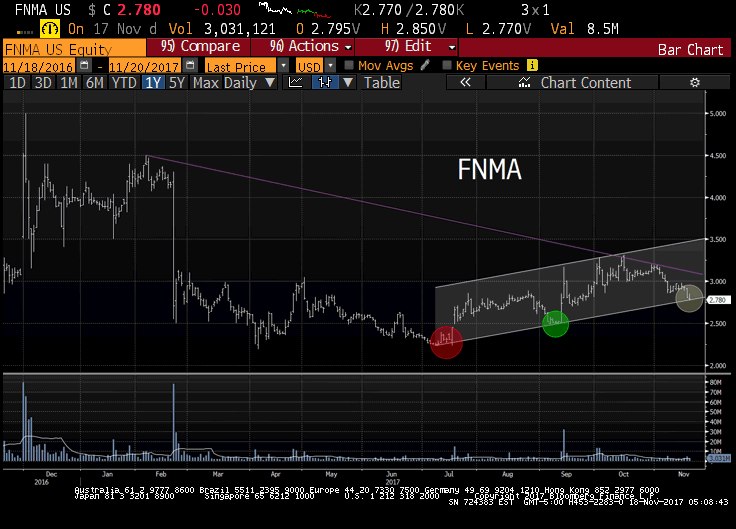 Bill Ackman’s Pershing Square Capital Management owns 44.7 million shares of FNMA, per the Bloomberg terminal. The LIFO cost basis is listed at $3.37 acquired over the last two years. This week, shares closed below their 200-day moving average. In the past five years, Fannie Mae crossed below this level 26 times and fell an average 1.7 percent in the next five days. It declined 17 times for an average loss of 3.9 percent, and advanced eight times for an average gain of 2.9 percent.
Bill Ackman’s Pershing Square Capital Management owns 44.7 million shares of FNMA, per the Bloomberg terminal. The LIFO cost basis is listed at $3.37 acquired over the last two years. This week, shares closed below their 200-day moving average. In the past five years, Fannie Mae crossed below this level 26 times and fell an average 1.7 percent in the next five days. It declined 17 times for an average loss of 3.9 percent, and advanced eight times for an average gain of 2.9 percent.
Nearly ten years after the financial crisis, Fannie and Freddie are still in “conservatorship.” This is the question that has many investors globally scratching their heads. Fannie and Freddie are still sweeping $25B a year to the U.S. Treasury, nearly $300B total (since heading the financial crisis). Few Americans realize, how to spend funds is at the President’s complete discretion. Boy did the Obama administration love this gravy train.
“Fannie Freddie will NOT be left in conservatorship”
US Treasury Secretary Steven Mnuchin, Bloomberg
Dodd-Frank has banks retaining capital at 20-year highs while Fannie and Freddie are retaining zero capital on $5T loan portfolio? The risks to the U.S. taxpayers here is COLOSSAL. There’s NO capital retention.
GSEs: “Fannie-Freddie Might Need $100B in the next Crisis”, FHFA Says
Policymakers also face a deadline of sorts. Fannie and Freddie are set to run out of capital early next year and would have to draw on Treasury if they suffered quarterly losses, a move that could spook the mortgage market. Lawmakers are hoping to cut a deal before that happens.
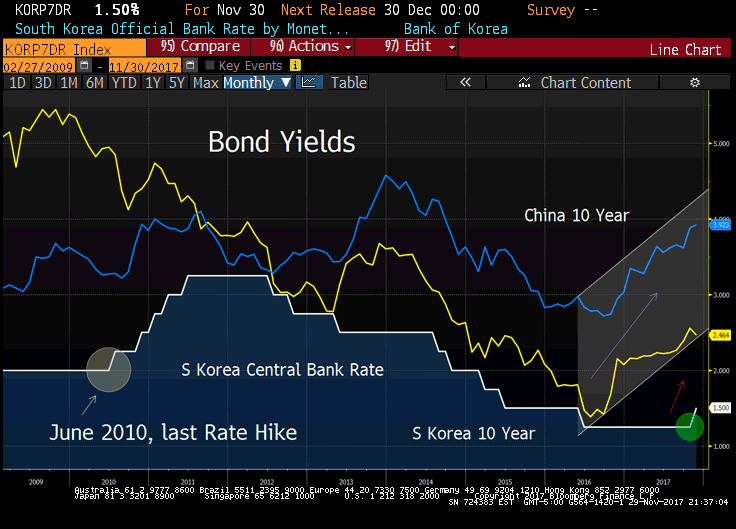 Thursday’s decision to raise the seven-day repurchase rate to 1.5 percent was forecast by 18 of 24 analysts surveyed by Bloomberg. The rest expected the central bank to leave the rate at a record-low 1.25 percent, where it has been since June 2016. As you can see above, markets widely anticipated this move – interest rates in China and S Korea have been on the rise for 15 months.
Thursday’s decision to raise the seven-day repurchase rate to 1.5 percent was forecast by 18 of 24 analysts surveyed by Bloomberg. The rest expected the central bank to leave the rate at a record-low 1.25 percent, where it has been since June 2016. As you can see above, markets widely anticipated this move – interest rates in China and S Korea have been on the rise for 15 months. 
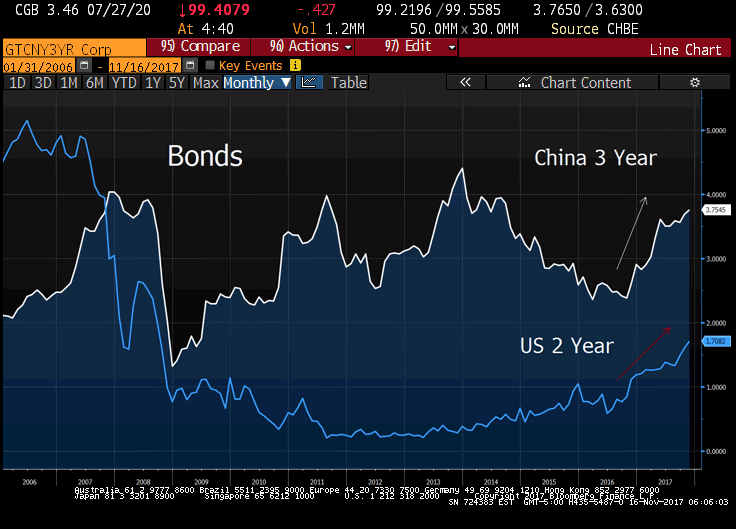 This week’s fears pushed China government bond yields to a 3-year high, taking U.S. two year Treasury bond yields north with them.
This week’s fears pushed China government bond yields to a 3-year high, taking U.S. two year Treasury bond yields north with them.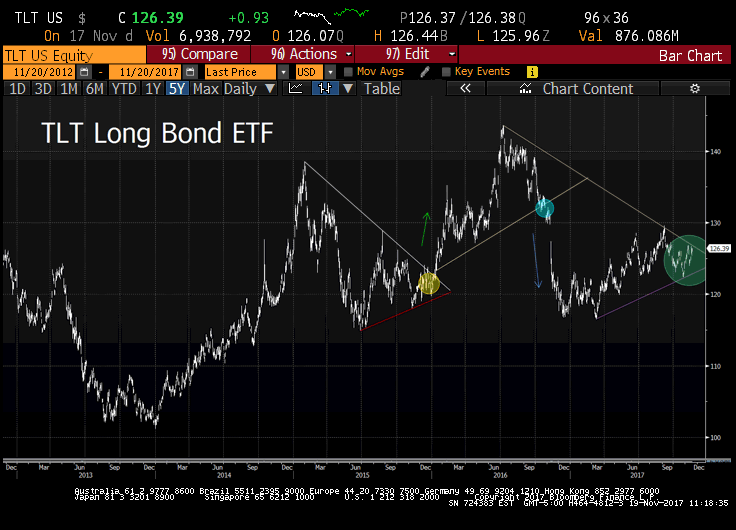 iShares 20+ Year Treasury Bond ETF seeks to track the investment results of an index composed of U.S. Treasury bonds with remaining maturities greater than twenty years. Over the last decade, wedge breaks in the technical chart pattern of the TLT have led to large moves in interest rates. Today. an important wedge is near a breach again, a true Bull – Bear battleground is forming (middle right above).
iShares 20+ Year Treasury Bond ETF seeks to track the investment results of an index composed of U.S. Treasury bonds with remaining maturities greater than twenty years. Over the last decade, wedge breaks in the technical chart pattern of the TLT have led to large moves in interest rates. Today. an important wedge is near a breach again, a true Bull – Bear battleground is forming (middle right above).  Bill Ackman’s Pershing Square Capital Management owns 44.7 million shares of FNMA, per the Bloomberg terminal. The LIFO cost basis is listed at $3.37 acquired over the last two years. This week, shares closed below their 200-day moving average. In the past five years, Fannie Mae crossed below this level 26 times and fell an average 1.7 percent in the next five days. It declined 17 times for an average loss of 3.9 percent, and advanced eight times for an average gain of 2.9 percent.
Bill Ackman’s Pershing Square Capital Management owns 44.7 million shares of FNMA, per the Bloomberg terminal. The LIFO cost basis is listed at $3.37 acquired over the last two years. This week, shares closed below their 200-day moving average. In the past five years, Fannie Mae crossed below this level 26 times and fell an average 1.7 percent in the next five days. It declined 17 times for an average loss of 3.9 percent, and advanced eight times for an average gain of 2.9 percent.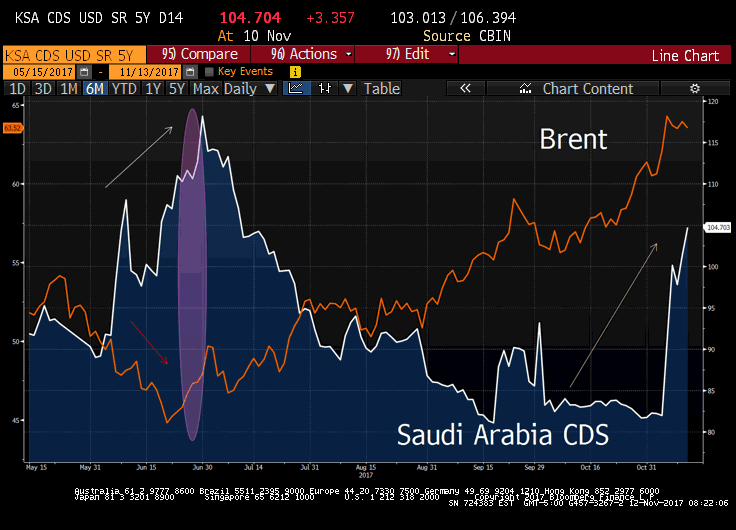 The cost of insuring Saudi Arabian debt from default is approaching two-year highs, even as oil prices globally are ripping upward. On our Bloomberg terminal, five-year CDS soared another 20 basis points last week. On the heels of a destabilizing “anti-corruption” purge in the kingdom, credit risk is on the rise. Increasing tensions with Hezbollah, an Iranian-backed militant group, have compounded investor concerns about rising political risks in the region. The last time the nation’s CDS jumped as much in a single week was in January 2016 at the height of the oil-market crash. Back then, Brent was $27, compared to $64 last week. The Kingdom’s debt profile has broadly expanded. Public debt outstanding in 2014 was down at $44B, today she’s approaching $300B, per Bloomberg data.
The cost of insuring Saudi Arabian debt from default is approaching two-year highs, even as oil prices globally are ripping upward. On our Bloomberg terminal, five-year CDS soared another 20 basis points last week. On the heels of a destabilizing “anti-corruption” purge in the kingdom, credit risk is on the rise. Increasing tensions with Hezbollah, an Iranian-backed militant group, have compounded investor concerns about rising political risks in the region. The last time the nation’s CDS jumped as much in a single week was in January 2016 at the height of the oil-market crash. Back then, Brent was $27, compared to $64 last week. The Kingdom’s debt profile has broadly expanded. Public debt outstanding in 2014 was down at $44B, today she’s approaching $300B, per Bloomberg data.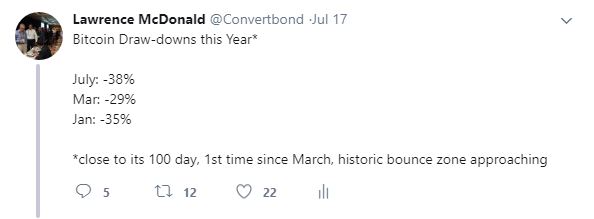
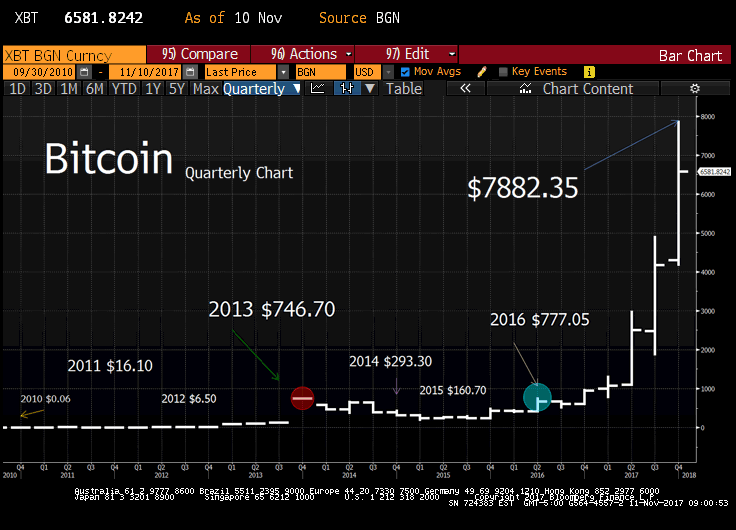 A 2013 investment in bitcoin took nearly three years to get back to even after a nearly 80% loss. Indeed, Bitcoin is not for the faint of heart.
A 2013 investment in bitcoin took nearly three years to get back to even after a nearly 80% loss. Indeed, Bitcoin is not for the faint of heart. 
